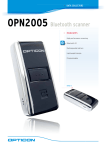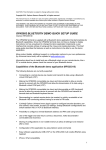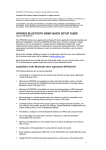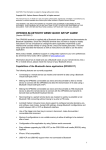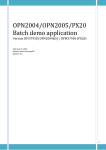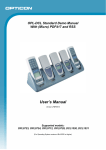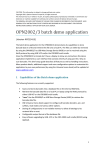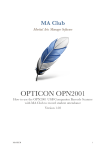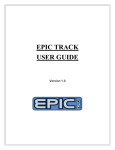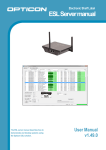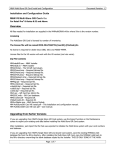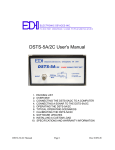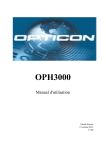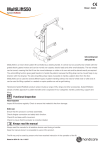Download User`s Manual Pocket Terminal PHL4100
Transcript
CAUTION: This information is subject to change without prior notice.
Copyright 2013, Opticon Sensors Europe BV, all rights reserved.
This manual may not, in whole or in part, be copied, photocopied, reproduced, translated or converted to any
electronic or machine readable form without prior written consent of Opticon Sensors Europe.
THE GENERAL USE AND FUNCTIONING OF THE BAR CODE SCANNER IS DESCRIBED IN THIS
DOCUMENT. ALSO GENERAL SETUP INSTRUCTIONS TO GET STARTED ARE DESCRIBED IN THIS
DOCUMENT. FOR FURTHER INSTRUCTIONS CONSULT OPTICON OR YOUR LOCAL DEALER.
OPN2005 BLUETOOTH DEMO QUICK SETUP GUIDE
(Version RFL37910)
The OPN2005 terminal is supplied with a Bluetooth demo application that demonstrates its
Bluetooth capabilities. Since the OPN2005 terminal does not have a display to display
instructions nor has a keyboard to change the demo application implements a user
interface that consists entirely of using just the 2 keys and reading barcodes. This brief
setup guide describes the features as well as instructions to be able to use this demo
application.
More product details, additional support or configuration options to your own preferences
(by Universal menu book) will be updated at www.opticon.com
Information about how to install and use a Bluetooth stack on your remote device, like a
PC or mobile device, please check the manual of your Bluetooth device.
Capabilities of the Bluetooth demo application (RFL37910)
The following features are currently supported:
Connecting to a remote device (as master) and transmit its data using a Bluetooth
virtual COM port (VCP)
Making the OPN2005 connectable (as slave) and discoverable to allow a remote
device to connect with the OPN2005 and allow the transmission of its data using a
Bluetooth virtual COM port (VCP)
Making the OPN2005 connectable (as slave) and discoverable as HID (keyboard)
device to allow the remote device to connect with the OPN2005 and transmit its
barcode data as Bluetooth keyboard device.
Reconnecting to a paired remote device (as master) to quickly re-establish a lost
Bluetooth HID connecting without having to re-enter a PIN code.
(Limited) Opticon Universal menu book support to configure barcode decoders, preand suffixes, read modes, buzzer/LED settings, change Bluetooth configurations and
switch between HID or VCP as Bluetooth interface.
Use of the trigger and clear key to connect, disconnect, make discoverable /
connectable and reconnect.
Storing of configurations in non-volatile memory to allow all settings to be restored
after a reset.
Configuration of the application by using Opticon serial commands
Easy software upgrading by USB (VCP) using Appload.
iPhone / iPad compatibility
USB-VCP and USB-HID support when not connected to Bluetooth
1
Configuring the Bluetooth demo application
Minimum required OS version
This demo application requires the following minimal OS version: RBLV0012.
If you want to check the currently installed OS and application version it is possible to
transmit both versions by USB-VCP by reading the 'Z1' menu label (See Universal menu
book chapter 7). It's also possible to use Appload (Utilities > Show software version) to
check the OS version.
Software updates
In the future more features and bug fixes are likely to be implemented into the OS of the
OPN2005 and this application. To find out if there are software updates available, please
check our web site. All available software and documentation for the OPN2005 can be
found under:
'Service and support' > 'Software' / 'Manuals' > 'OPN2005' at www.opticon.com.
Supported defaults
The following default settings are supported.
(The labels below can be read without reading any SET/END labels)
Bluetooth VCP *
(default)
Bluetooth HID *
* If you only have a Opticon Universal menu book available which doesn't list 'C02' or 'C05'
as supported defaults, it's possible to use RS232 ('U2') or Bluetooth ('SO') instead of 'C05'.
In case it’s required to (also) be able to transmit any scanned barcodes using USB-VCP
(COM port) or USB-HID (keyboard), then this is possible by reading one of the labels
below.
USB-VCP
(+ Bluetooth VCP)
USB-HID
(+ Bluetooth HID)
Notes:
When using USB-HID it’s not directly possible to load software using Appload. To
be able to load software, switch back to Bluetooth-VCP or USB-VCP default.
Transmission by USB only works while not being connected to Bluetooth
2
Connecting your OPN2005 as Bluetooth keyboard (HID)
The first step of connecting your OPN2005 as Bluetooth keyboard to a remote device is to
make sure the Bluetooth HID default is configured (see 'Supported defaults').
When using Bluetooth HID, the remote device always has to make the first connection
attempt. Therefor it is not necessary to configure the remote Bluetooth address, but you
will have to make your OPN2005 discoverable and connectable to allow the remote device
to find, pair and connect to your OPN2005.
To make your OPN2005 discoverable and connectable (for 2 minutes) keep the small clear
key pressed for 5 seconds till the blue LED starts blinking. When this is done, let your
remote device discover all Bluetooth devices in range to find your OPN2005.
Print screen of an OPN2005 that has been discovered on a remote PC.
After you've discovered your OPN2005 you can try to let your remote device connect with
your OPN2005.
Depending on your Operating System and Bluetooth stack you will either be asked to enter
any PIN code on your remote device or you will be shown a random PIN code. Either way
you will be requested to enter that same PIN code on your OPN2005.
If you are allowed to enter any PIN code, then it is easiest to choose the last 4 digits of the
Bluetooth address of your OPN2005 as PIN code since that is the default PIN code of your
OPN2005. To skip having to enter a PIN code on your OPN2005 read the 'Fixed PIN code'
label below to configure this. To change this configuration back to default again (= entering
the PIN code manually) you can read the other label.
Use fixed PIN code
Enter PIN code manual
(using numeric direct input labels)
3
If you want to use a different PIN code or you are only allowed to enter a random PIN code
on your OPN2005, then you will have to enter this PIN code using direct input labels.
These labels can be found in the universal menu book (or below). After entering the PIN
code read the END label to send the PIN code to the remote device.
When executed correctly your OPN2005 should now be connected as keyboard and you
should be allowed to scan and transmit barcodes as keyboard data. If the remote device
does establish the pair, but doesn't automatically connect, you might have to manually
connect afterwards by pressing the trigger key for 5 seconds.
To manually end a connection you can press the small clear key for 5 seconds to
disconnect your OPN2005.
If you've lost your connection, then the OPN2005 will try to reconnect automatically for
about 1 minute, but if that fails you can reconnect manually by pressing the trigger key for
5 seconds. The trigger key allows you to reconnect without having to enter the PIN code
again as long as the remote device doesn't lose the pairing information and the OPN2005
wasn't reset to default or the remote Bluetooth address was changed.
If the pair was ever lost or you want to connect to another remote device you will have use
the clear key again to make your OPN2005 connectable and allow the remote device to
connect and pair with your terminal.
4
Connecting your OPN2005 as a Virtual Com port (VCP)
The first step of connecting your OPN2005 as Bluetooth Virtual Com Port to a remote
device is to make sure that Bluetooth VCP default is configured (see 'Supported defaults').
When using Bluetooth VCP, the remote device can either connect to your OPN2005 (slave
mode) or your OPN2005 can connect to remote device (as master).
Configuring a remote Bluetooth address
If you want the OPN2005 to connect to a remote device (as master) it will be necessary to
configure the Bluetooth address of the remote device first.
Usually the address is displayed on the product label as a hexadecimal code (example: 0011-F6-03-39-69). Otherwise consult the documentation of the device to learn how to
retrieve the Bluetooth address. To configure this Bluetooth address in the OPN2005 you'll
have to create a barcode label containing this hexadecimal code as described below.
Opticon provides a simple on-line application on for this purpose:
http://opticonfigure.opticon.com/bluetooth.asp
Type in the digits of the hexadecimal code in numbers and capital characters without
dashes, dots and spaces (example: 0011F6033969).
Submit the code into a barcode and print the screen to have it available for scanning.
After you've created the barcode, you can scan the barcode to configure the Bluetooth
address and save it in non-volatile memory. (The OPN2005 will automatically try to
establish a Bluetooth connection when reading this label).
5
Connect as master
Depending on the Operating System and Bluetooth stack of your desktop computer, laptop
or mobile Bluetooth device, it is necessary to first open the (incoming) Bluetooth Virtual
Com port, before you will be able to connect your OPN2005 as master to your device.
Using applications like Hyperterminal or the RS232 monitor of Appload it is possible to
open the Bluetooth Virtual Com Port. For more information on how to open a COM port,
please refer to documentation of your remote Bluetooth device.
The first time you try to connect your OPN2005 to a Bluetooth device you will have to scan
the created Bluetooth address label. After that, it will also be possible to do a connection
attempt by pressing the trigger key for 5 seconds (until the blue LED starts blinking).
If you haven't disabled authentication on your remote device, then you will be requested to
enter a PIN code (or passkey). The default PIN code of the OPN2005 equals the last 4
digits of the Bluetooth address. These last 4 digits of the Bluetooth address are also shown
in the Bluetooth name of the OPN2005. If you wish to use a different PIN code, then this is
possible by using the 'Set/end PIN-code label' menu options, which can be found in
chapter 2.3.2 of the Universal menu book.
Example of a request on a Windows device to enter a passkey (a.k.a. PIN-code)
When executed correctly your OPN2005 should now be connected as Virtual Com port to
your remote device and you should be able to scan and transmit barcodes as serial data.
If you've lost your connection or closed the virtual com port, then the OPN2005 will try to
reconnect for about 1 minute. After that you can reconnect manually by pressing the trigger
key for 5 seconds. To change this auto reconnect time, use the menu options found in
chapter '2.3.6 Auto reconnect options' of the Universal menu book.
To manually end your connection you can press the small clear key for 5 seconds to
disconnect your OPN2005.
6
Connect as slave
When you want a remote Bluetooth device to connect with your OPN2005, then it is not
necessary to configure the remote Bluetooth address, but you will have to make your
OPN2005 discoverable and connectable to allow the remote device to find and connect to
your OPN2005.
To make your OPN2005 discoverable and connectable for 2 minutes, keep the small clear
key pressed for 5 seconds until the blue LED starts blinking. After that you should let your
remote device discover all Bluetooth devices in range to find your OPN2005.
Screenshot of discovered Bluetooth devices.
After you've successfully discovered your OPN2005 you can try to let your remote device
pair with your OPN2005.
If you haven't disabled authentication on your remote device, then you will be requested to
enter a PIN code (or passkey) on your remote device. The default PIN code of the
OPN2005 equals the last 4 digits of the Bluetooth address. These last 4 digits of the
Bluetooth address are also shown in the Bluetooth name of the OPN2005. If you wish to
use a different PIN code, then this is possible by using the 'Set/End PIN-code label' menu
options, which can be found in chapter 2.3.2 of the Universal menu book.
7
Screenshot of entering a passkey (a.k.a. PIN-code) on a Windows device
If successful, the OPN2005 should now be successfully paired with your remote Bluetooth
device and the Virtual Com port ready to be used.
To be able to scan and transmit barcodes as serial data, open the Bluetooth Virtual Com
port on your remote device to establish the connection with the OPN2005
If you've lost your connection or closed the Virtual Com port, then the OPN2005 will stay
connectable for about 2 minutes*. After those 2 minutes, use the small key to make the
OPN2005 connectable again and allow the remote device to re-establish the connection.
To manually end your connection, press the small clear key for 5 seconds to disconnect
your OPN2005.
* The labels below allow you to change the time that the OPN2005 will stay connectable
8
Limited Universal menu book support
In contrary to other Opticon programmable terminals, the OPN2005 also supports the
reading of various configuration options that can be found in the Universal menu book.
This makes it possible to customize this application without having to actually change the
source code of this application.
The OPN2005 support (most of the) menu options listed in the following chapters:
1. Defaults (See chapter 'Supported defaults' at the start of this set-up guide)
2.3. Bluetooth options (See 'Supported Bluetooth features' below)
3.1 Enabling/disabling readable codes
3.2 Setting of fixed, minimum and maximum lengths
3.3 Code specific options (almost all options are supported except some 2D decoder
options)
4.1 Case conversion
4.2 Set prefixes
4.3 Set suffixes
5.1 Read modes, add-on wait modes
5.1.1 Multiple read reset time
5.1.2 Quite zone options (margins)
5.2. Read time options
5.4 Redundancy
5.5 Positive and negative barcodes
6.1 Buzzer settings
6.2 Good read LED
7.1 Diagnostics
7.2 Enabling / disabling configuring via serial commands
Supported Bluetooth features
In the Opticon Universal menu book there are additional Bluetooth features listed for
Opticon barcode readers with Bluetooth support. Some of these features are also available
on this demo application.
The following of these listed features are supported:
Chapter 2.3.1: Bluetooth connection labels
+-CONN-+
(Manually connect label)
+-DISC-+
(Manually disconnect label)
+-DSCO-+
(Make discoverable / connectable)
Chapter 2.3.2: Bluetooth security (Authentication / encryption)
Chapter 2.3.3: Configurable Trigger-to-connect time (default = 5 seconds)
Chapter 2.3.4: Configurable Trigger-to-disconnect time (default = 5 seconds)
Chapter 2.3.6: Auto reconnect options (default = 1 minute)
Chapter 2.3.7: Wireless power saving options
Apple iPhone/iPad support
When iPhone/iPad mode is enabled it’s possible to toggle the onscreen keyboard and use
the trigger key to wake up the iPhone/iPad from standby. It is recommended to disable the
passcode lock option to prevent barcodes from being entered as passcode when waking
up from standby.
_+-IOSON-+_
Enable iPhone/iPad mode
_+-IOSOFF-+_
Disable iPhone/iPad mode
Read one of the labels above to enable/disable iPhone compatibility.
9
MEMORIZING
This application does not support memorizing of barcodes in case the OPN2005 loses its
connection with a remote Bluetooth device.
If memorizing is desired, it's possible to load the advanced Bluetooth application on the
OPN2005, which does support memorizing. This application can be found at:
'Service and support' > 'Software' / 'Manuals' > 'OPN2005' at www.opticon.com.
10
Other OPN2005 applications
Besides this Bluetooth demo application there are 3 other OPN2005 applications available
on our web site that might fit your specific application better.
1. Software V37275: OPN2001 simulation demo application
This application turns the OPN2005 into an OPN2001 compatible batch scanner.
Besides USB, any stored barcode data can also be retrieved from the OPN2005 by using
Bluetooth.
Use this OPN2005 application in combination with the OPN2001 Demo application for
Windows (or develop your own application using the SDK that's available for the
OPN2001).
Note: When planning to use the OPN2005 solely as on standard OPN2001, so without
Bluetooth or need to run other applications, please note the following (hardware)
differences:
The OPN2005 does not support laser aiming (laser dot) at this moment
The OPN2005 cannot change its scan angle to shorten the laser line at this moment
2. Software Vxxxx: Batch demo application
This software turns the OPN2005 into a batch scanner that can transmit it data as a file.
Use this application in combination with the OseComm Windows application.
The output format of the barcode file (comma separated) can be configured using the setup chart that can be found in the included manual.
Note: This application will soon be available
3. Software Vxxxx: Advanced Bluetooth application
This application is very similar to the application described in this manual, but supports
more of Bluetooth options that are listed in the Universal menu book.
This application is recommended when the OPN2005 is used as replacement for the old
OPL2724 / OPL7724 and when memorizing of barcodes is desired if the OPN2005 lost its
Bluetooth connection or is out-of-range.
Note: This application will soon be available
11
Trouble shooting
Since the OPN2005 doesn't have a display, it also doesn't have a system menu to resort to
when a crashing application or OS prevents you from loading new software on the
OPN2005.
For this reason the OPN2005 has a few escape mechanisms to allow you to restart, halt
your application and/or install new software. This can be very useful in case the OPN2005
has crashed or is constantly restarting due to a crashing application.
Restart mechanisms
Automatic
The OPN2005 has a watchdog timer to determine whether the OS is still
running or has crashed. This watchdog will cause the OPN2005 to restart after
3 seconds if the OS has crashed. This watchdog timer will not cause a restart
when only the application has crashed.
Manually
The OPN2005 has a manual restart mechanism that allows you to restart in
situations that the OS is still running, but your the application has crashed. In
order to activate this mechanism, press and hold both the trigger and delete
key for at least 20 seconds. After the OPN2005 has sounded the restart beep,
you can release both keys to complete the restart.
Halting your application
Firstly, make sure your battery isn't empty and your mini-USB cable is not connected to
the OPN2005.
Then restart your application using one of the two restart methods listed above, while
keeping the keys pressed.
Release the trigger key to halt the application.
If successful, the LED of your OPN2005 should now be blinking orange. You should now
be able to load new application or OS software.
To exit the halted application state, press both keys for 20 seconds
Halting the Operating System (only necessary in case a corrupt OS is installed)
Firstly, make sure your battery isn't empty and your mini-USB cable is not connected to
the OPN2005.
Then restart your application using one of the 2 methods listed above, while keeping
the delete key pressed.
While keeping the delete key pressed, insert the mini-USB cable into the OPN2005 to
halt the Operating system.
If successful, the LED of your OPN2005 should now be blinking red. You should now be
able to load a new OS.
To exit the halted Operating state, press both keys for 3 seconds
12
Version history *
RFL37910
First release
March 21, 2013
(with OS version
RBLV0012)
* Bug fixes and added features in the Operating System of the OPN2005 are not listed in
the application version history above.
Please check our web site at www.opticon.com to see if there are updates
available for the Operating System, this application and this manual.
13













